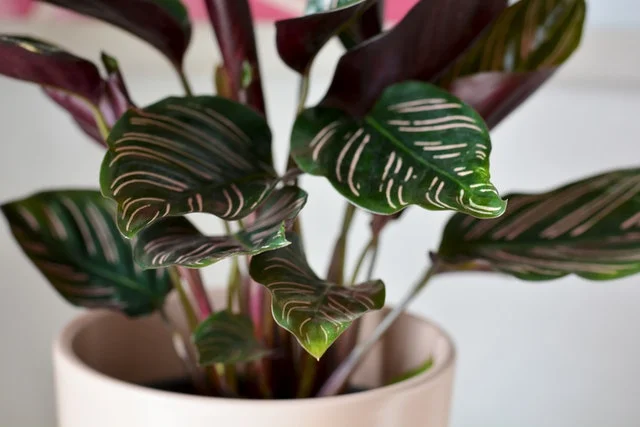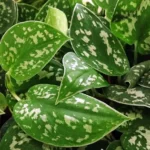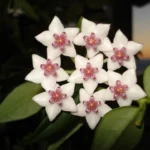Table of Contents
Caring for Calathea Medallion
Calathea Medallion, also known as Calathea roseopicta or rose-painted prayer plant, is native to Brazil.
It’s popular as a houseplant because of the patterning on the leaves, which look painted with light, feathery shapes against a dark green background.
The Calathea Medallion has burgundy undersides that show at night when the leaves lift upward, a distinctive feature of Calathea or prayer plants.
It’s a good choice of houseplant for people who already have tropical plants or who are willing to learn how to care for them and create the right environment.
Helping Calathea Medallion Thrive
Calathea Medallion can really thrive under the right circumstances. Its oval leaves grow largest and have the best color variation when the Medallion is given medium to bright indirect light, high humidity, warmth, and moist soil that isn’t too wet.
While that can sound like a lot if you haven’t worked with tropical plants before, it’s not bad once you get started.
Yellow leaves, brown leaves, or leaves curling inward all indicate that something is wrong in the Calathea Medallion’s environment. Since the leaves allow room for pests to hide, you’ll also want to keep an eye out for signs of infestation.
Light Requirements
Calathea Medallion needs medium or bright light, but the light should be indirect or diffuse. If the plant isn’t getting enough light, its colors will fade, and if the lack of light goes too far, it may start dying.
Be careful to avoid direct sunlight, especially in warmer climates and during summer when the sun is at its hottest.
The Calathea Medallion is a forest floor plant, which means it’s not accustomed to receiving light this way, and sun will quickly burn the leaves.
Temperature Requirements
The Calathea Medallion does well in fairly standard household temperatures, with ideal ranges between 65 and 85 degrees Fahrenheit.
The more the plant is at the lower end of this range, the slower its growth will be. It’s much more tolerant to being a little too warm than it is to being a little too cold.
Soil Requirements
Calathea Medallion does best with soil that drains well but holds onto some moisture. This can be accomplished with a mix containing peat and perlite.
It’s also important to make sure there’s a way for the soil to drain properly.
Humidity Requirements
The Calathea Medallion appreciates high humidity, but it can do okay at average humidity. If you live in a climate with low humidity, you may want to invest in a humidifier.
You can also add some ambient humidity by moving the plant to a bathroom (if there’s enough light) or by setting out some bowls or plates of water.
Since this is a pretty common requirement for tropical plants, you can also keep tropical plants together so that they benefit from a collective increase in humidity.
Dry leaves are a good indicator that the plant could use a bit more humidity.
How to Water Calathea Medallion
Calathea plants like moist soil, but the soil can’t stay too wet or it will lead to root rot. Check the top inch of soil in the plant. If this is starting to dry out, it’s probably time to water it.
If you see yellowing leaves, this means the plant is getting too much water. Wait until the soil is a little more dried out to water again, or double check the drainage and soil type.
If leaves start turning yellow or brown just at the edges and looking burnt, this may be from mineral build up. The Medallion does best with filtered water or rainwater.
How to Fertilize Calathea Medallion
Calathea Medallion doesn’t need a lot of fertilizer. You can apply a very diluted fertilizer once a month or a fertilizer diluted to half every two to three months.
Avoid giving the plant fertilizer during winter, as growth naturally slows during this time.
Pruning Calathea Medallion
Calathea Medallion does not require regular pruning. Since it is comprised of single-leaf stems, you should really only remove dead or dying leaves.
Propagation of Calathea Medallion
Propagation of Calathea Medallion takes a gentle, patient hand. Remove the whole plant from the pot.
You should be able to see where the stems separate from each other at the roots. Use one of these natural separations and gently, slowly pull the roots apart, untangling if necessary. Try to avoid tearing any of the roots in the process.
Repot each section, using fresh soil to give the plants the best nutrients and the best chance at thriving after propagation. Keep in mind that they might need a little extra attention while they recover over the next 2-4 weeks.
Extra Tips For Calathea Medallion Care
Pests and Diseases
Like most tropical houseplants, Calathea Medallion is prone to root rot. This can be avoided by not overwatering the plant and not allowing water to sit against the roots.
Ridding Calathea Medallion of Fungus or Mildew
Plants with large leaves and certain textures tend to attract fungus or mildew and can benefit from regular cleaning using a damp cloth.
If you see white patches on the leaves, wash off the white spots gently with a damp cloth, making sure not to leave any water resting on the leaves.
It can be a good idea to apply neem oil afterward, especially if this is a recurring problem.
Ridding Calathea Medallion of Pests
If you see signs of pests, which are generally easiest to spot underneath the leaves, manually remove any pests, webs, or eggs and wipe down the plant.
You can use rubbing alcohol or a gentle insecticide. Be sure to also check nearby plants to make sure they don’t have the same problem. Neem oil can help here, too.
If you see thrips, you’ll also want to change out at least the top layer of soil, since that’s where they lay their eggs.
Toxicity
Calathea Medallion is non-toxic and safe to keep around pets and small children. Some report that the Medallion is tasty to household pets, so you may still want to keep the plant out of their reach.
Quick Reference
- Light: Medium to bright, indirect or diffuse
- Temperature: 65 to 85 degrees Fahrenheit
- Soil: Mix of peat/perlite
- Humidity: 50% or higher
- Water: As needed when top soil is starting to dry
- Pruning: Dead or dying leaves only
Photo by Nina Pintar from Pexels


